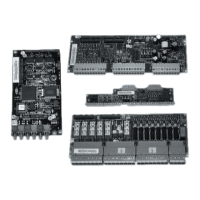Functional Software description
28 DCS 500 Software Description
Selecting of the
Ramp function
It is possible to define two different acceleration, deceleration and
smoothing time constants. A typical application for this feature is
two DC-motors connected to one drive and each motor is operated
separately. The application program in the drive may also select
different ramp times in different control situations.
Selection can be done by input pin [T1/T2] (1707). If input [T1/T2]
(1707) is in logical state 0, then the values of the parameters
ACCEL 1 (1708), DECEL 1 (1709) and SMOOTH 1 (1710) define
the ramp function as seen in figure above.
If input [T1/T2] is in logical state 1 then the values of the parame-
ters ACCEL 2 (1711), DECEL 2 (1712) and SMOOTH 1 (1713)
define the ramp function.
Limitation of the
reference
Parameter SPEEDMAX (1715) defines the maximum reference
value and SPEEDMIN (1716) the minimum value after the RAMP
block.
Passing of the
RAMP function
The ramp function can be bypassed by setting the input [FOLLOW
IN] (1704) to logical state 1.
Output follows
the speed actual
The output OUT (11701) can be made to follow the speed actual
by setting the input [FOLL ACT] (1705) to logical state 1.
Reset the output The output OUT (11701) can be set to zero by setting the input
[RES OUT] (1706) to logical state 1.
Acceleration
compensation
The output ACCEL COMP (11702) is giving the additional torque
reference which is needed to compensate inertia of load. The ac-
celeration compensation mode is selected by parameter ACC
COMP.MODE (1718). The time in which the drive will accelerate
from zero speed to max. speed using motor nominal torque is set
to parameter ACC COMP.TRMIN (1719)

